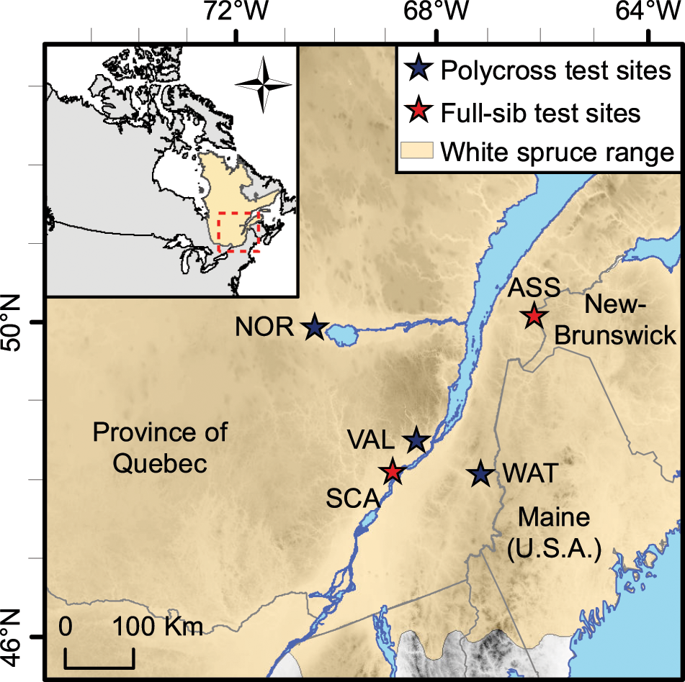Our official English website, www.x-mol.net, welcomes your feedback! (Note: you will need to create a separate account there.)
Genomic prediction for hastening and improving efficiency of forward selection in conifer polycross mating designs: an example from white spruce
Heredity ( IF 3.8 ) Pub Date : 2020-01-22 , DOI: 10.1038/s41437-019-0290-3 Patrick R N Lenz 1, 2 , Simon Nadeau 1 , Aïda Azaiez 2 , Sébastien Gérardi 2 , Marie Deslauriers 1 , Martin Perron 2, 3 , Nathalie Isabel 2, 4 , Jean Beaulieu 2 , Jean Bousquet 2
Heredity ( IF 3.8 ) Pub Date : 2020-01-22 , DOI: 10.1038/s41437-019-0290-3 Patrick R N Lenz 1, 2 , Simon Nadeau 1 , Aïda Azaiez 2 , Sébastien Gérardi 2 , Marie Deslauriers 1 , Martin Perron 2, 3 , Nathalie Isabel 2, 4 , Jean Beaulieu 2 , Jean Bousquet 2
Affiliation

|
Genomic selection (GS) has a large potential for improving the prediction accuracy of breeding values and significantly reducing the length of breeding cycles. In this context, the choice of mating designs becomes critical to improve the efficiency of breeding operations and to obtain the largest genetic gains per time unit. Polycross mating designs have been traditionally used in tree and plant breeding to perform backward selection of the female parents. The possibility to use genetic markers for paternity identification and for building genomic prediction models should allow for a broader use of polycross tests in forward selection schemes. We compared the accuracies of genomic predictions of offspring’s breeding values from a polycross and a full-sib (partial diallel) mating design with similar genetic background in white spruce ( Picea glauca ). Trees were phenotyped for growth and wood quality traits, and genotyped for 4092 SNPs representing as many gene loci distributed across the 12 spruce chromosomes. For the polycross progeny test, heritability estimates were smaller, but more precise using the genomic BLUP (GBLUP) model as compared with pedigree-based models accounting for the maternal pedigree or for the reconstructed full pedigree. Cross-validations showed that GBLUP predictions were 22–52% more accurate than predictions based on the maternal pedigree, and 5–7% more accurate than predictions using the reconstructed full pedigree. The accuracies of GBLUP predictions were high and in the same range for most traits between the polycross (0.61–0.70) and full-sib progeny tests (0.61–0.74). However, higher genetic gains per time unit were expected from the polycross mating design given the shorter time needed to conduct crosses. Considering the operational advantages of the polycross design in terms of easier handling of crosses and lower associated costs for test establishment, we believe that this mating scheme offers great opportunities for the development and operational application of forward GS.
中文翻译:

针叶树多交配设计中加速和提高正向选择效率的基因组预测:以白云杉为例
基因组选择(GS)在提高育种值预测准确性和显着缩短育种周期长度方面具有巨大潜力。在这种情况下,交配设计的选择对于提高育种操作的效率和获得每单位时间最大的遗传增益变得至关重要。Polycross 交配设计传统上用于树木和植物育种,以执行母本的反向选择。使用遗传标记进行亲子鉴定和建立基因组预测模型的可能性应该允许在前向选择方案中更广泛地使用多交叉测试。我们比较了白云杉(Picea glauca)中具有相似遗传背景的多杂交和全同胞(部分双列)交配设计对后代育种值的基因组预测的准确性。对树木的生长和木材质量性状进行表型分析,并对 4092 个 SNP 进行基因分型,这些 SNP 代表分布在 12 个云杉染色体上的基因位点。对于多交叉后代测试,遗传力估计值较小,但使用基因组 BLUP (GBLUP) 模型与考虑母系谱系或重建的完整谱系的基于谱系的模型相比更精确。交叉验证表明,GBLUP 预测比基于母系谱系的预测准确度高 22-52%,比使用重建的全谱系的预测准确度高 5-7%。对于多杂交(0.61-0.70)和全同胞后代测试(0.61-0.74)之间的大多数性状,GBLUP 预测的准确性很高并且在相同范围内。然而,鉴于进行杂交所需的时间更短,预计多交配设计中每单位时间的遗传增益更高。考虑到多交叉设计在更容易处理交叉和较低的测试建立相关成本方面的操作优势,我们相信这种交配方案为前向GS的开发和操作应用提供了巨大的机会。
更新日期:2020-01-22
中文翻译:

针叶树多交配设计中加速和提高正向选择效率的基因组预测:以白云杉为例
基因组选择(GS)在提高育种值预测准确性和显着缩短育种周期长度方面具有巨大潜力。在这种情况下,交配设计的选择对于提高育种操作的效率和获得每单位时间最大的遗传增益变得至关重要。Polycross 交配设计传统上用于树木和植物育种,以执行母本的反向选择。使用遗传标记进行亲子鉴定和建立基因组预测模型的可能性应该允许在前向选择方案中更广泛地使用多交叉测试。我们比较了白云杉(Picea glauca)中具有相似遗传背景的多杂交和全同胞(部分双列)交配设计对后代育种值的基因组预测的准确性。对树木的生长和木材质量性状进行表型分析,并对 4092 个 SNP 进行基因分型,这些 SNP 代表分布在 12 个云杉染色体上的基因位点。对于多交叉后代测试,遗传力估计值较小,但使用基因组 BLUP (GBLUP) 模型与考虑母系谱系或重建的完整谱系的基于谱系的模型相比更精确。交叉验证表明,GBLUP 预测比基于母系谱系的预测准确度高 22-52%,比使用重建的全谱系的预测准确度高 5-7%。对于多杂交(0.61-0.70)和全同胞后代测试(0.61-0.74)之间的大多数性状,GBLUP 预测的准确性很高并且在相同范围内。然而,鉴于进行杂交所需的时间更短,预计多交配设计中每单位时间的遗传增益更高。考虑到多交叉设计在更容易处理交叉和较低的测试建立相关成本方面的操作优势,我们相信这种交配方案为前向GS的开发和操作应用提供了巨大的机会。


























 京公网安备 11010802027423号
京公网安备 11010802027423号